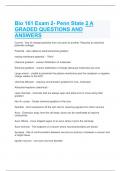Bio 161 exam - Study guides, Class notes & Summaries
Looking for the best study guides, study notes and summaries about Bio 161 exam? On this page you'll find 92 study documents about Bio 161 exam.
Page 3 out of 92 results
Sort by
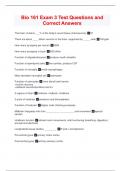
-
Bio 161 Exam 3 Test Questions and Correct Answers
- Exam (elaborations) • 10 pages • 2024
- Available in package deal
-
- $10.49
- + learn more
The brain contains ___% of the body's neural tissue (interneurons) 97 There are about ____ billion neurons in the brain, supported by _____ cells 100;glial How many synapses per neuron 5000 How many synapses in brain 500 trillion Function of oligodendrocytes produce myelin sheaths Function of ependymal cells line cavities, produce CSF Function of microglia small macrophages Most abundant neuroglial cell astrocytes Function of astrocytes -form blood brain barrier -nourish neurons -reabso...
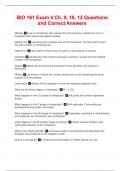
-
BIO 161 Exam 4 Ch. 9, 10, 12 Questions and Correct Answers
- Exam (elaborations) • 11 pages • 2024
- Available in package deal
-
- $8.99
- + learn more
Meiosis Type of cell division that reduces the chromosome number from 2n to n. Daughter cells receive the haploid number Diploid (2n) containing two complete sets of chromosomes, one from each parent. the total number of chromosomes. Haploid (n) cell condition where only one type of chromosome is present Gametes reproductive cells (sperm and egg in animals). usually have the haploid number of chromosomes Zygote diploid cell formed by the production of two gametes; the product of fertilizatio...
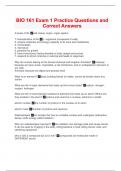
-
BIO 161 Exam 1 Practice Questions and Correct Answers
- Exam (elaborations) • 7 pages • 2024
- Available in package deal
-
- $8.99
- + learn more
4 levels of life cell, tissue, organ, organ system 7 characteristics of life 1. organized (composed of cells) 2. acquire materials and energy (capacity to do work and metabolize) 3. homeostatic 4. reproduce 5. potential for growth 6. have evolutionary history/heredity of traits (adapt and evolve) 7. respond to stimuli (internal or external and leads to response) Why do humans belong to the domain Eukarya and kingdom Animalia? Eukarya: because we have nuclei, organelles, a cell membrane, and an...
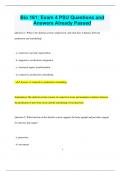
-
Bio 161: Exam 4 PSU Questions and Answers Already Passed
- Exam (elaborations) • 31 pages • 2024
- Available in package deal
-
- $10.49
- + learn more
Bio 161: Exam 4 PSU Questions and Answers Already Passed Question 1: What is the skeletal system composed of, and what does it balance between production and remodeling? - a. connective; growth; regeneration - b. supportive; ossification; integration - c. structural; repair; transformation - d. connective; production; remodeling - Answer: d. connective; production; remodeling Explanation: The skeletal system consists of connective tissue and maintains a balance between the pro...

-
Cal Poly Bio 161 Final Exam Questions and Answers Graded A+
- Exam (elaborations) • 32 pages • 2024
-
- $10.49
- + learn more
Cal Poly Bio 161 Final Exam Questions and Answers Graded A+ Question 1: What are the light-dependent reactions in photosynthesis primarily responsible for? - a. producing sugars - b. using light energy to generate ATP and NADPH - c. fixing carbon dioxide - d. synthesizing glucose - Answer: b. using light energy to generate ATP and NADPH Explanation: The light-dependent reactions harness energy from light to produce ATP and NADPH, which are used in the subsequent Calvin Cycle. ...
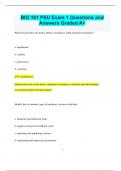
-
BIO 161 PSU Exam 1 Questions and Answers Graded A+
- Exam (elaborations) • 21 pages • 2024
- Available in package deal
-
- $9.99
- + learn more
BIO 161 PSU Exam 1 Questions and Answers Graded A+ What term describes the body's ability to maintain a stable internal environment? a. equilibrium b. stability c. homeostasis d. constancy c. homeostasis Homeostasis refers to the body's capability to maintain a consistent and stable internal environment despite external changes. Identify the two primary types of regulatory systems in the body. a. balancing and enhancing loops b. negative and positive feedback cycles c...
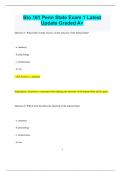
-
Bio 161 Penn State Exam 1 Latest Update Graded A+
- Exam (elaborations) • 18 pages • 2024
- Available in package deal
-
- $9.99
- + learn more
Bio 161 Penn State Exam 1 Latest Update Graded A+ Question 1: What field of study focuses on the structure of the human body? - a. anatomy - b. physiology - c. homeostasis - d. ion - Answer: a. anatomy Explanation: Anatomy is concerned with studying the structure of the human body and its parts. Question 2: Which term describes the function of the human body? - a. anatomy - b. physiology - c. homeostasis - d. ion 2 - Answer: b. physiology Explanation: Physio...
Bio 161 Exam 2- Penn State 2 A GRADED QUESTIONS AND ANSWERS
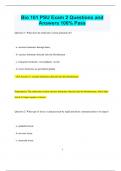
-
Bio 161 PSU Exam 2 Questions and Answers 100% Pass
- Exam (elaborations) • 14 pages • 2024
- Available in package deal
-
- $9.99
- + learn more
Bio 161 PSU Exam 2 Questions and Answers 100% Pass Question 1: What does the endocrine system primarily do? - a. secretes hormones through ducts - b. secretes hormones directly into the bloodstream - c. transports hormones via lymphatic vessels - d. stores hormones in specialized glands - Answer: b. secretes hormones directly into the bloodstream Explanation: The endocrine system releases hormones directly into the bloodstream, which then travel to target organs or tissues. ...
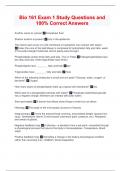
-
Bio 161 Exam 1 Study Questions and 100% Correct Answers
- Exam (elaborations) • 3 pages • 2024
- Available in package deal
-
- $8.99
- + learn more
Another name for cytosol intracellular fluid Stratum lucidum is present only in the epidermis The interior part (core) of a cell membrane is hydrophilic (can interact with water) False (the core of the lipid bilayer is comprised of hydrophobic fatty acid tails- water or the polar/charged molecules cannot easily pass through) Phospholipids contain three fatty acid tails, True or False False(phospholipids have two fatty acid tails, while triglycerides have three) Phospholipids have ________ fa...

How did he do that? By selling his study resources on Stuvia. Try it yourself! Discover all about earning on Stuvia



